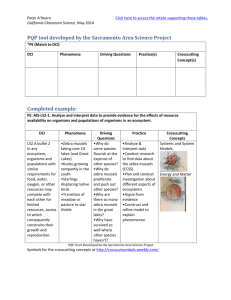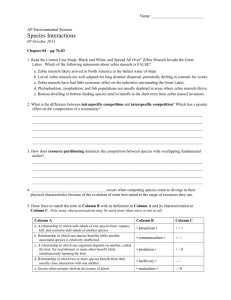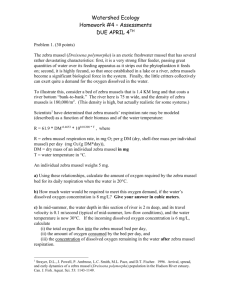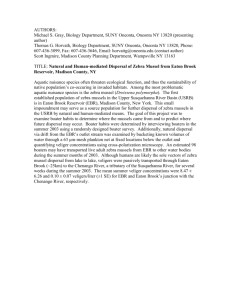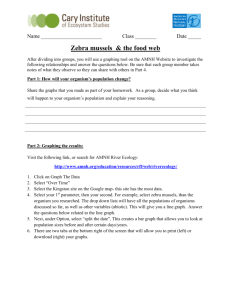Zebra Mussel FAQs About Monitoring
advertisement
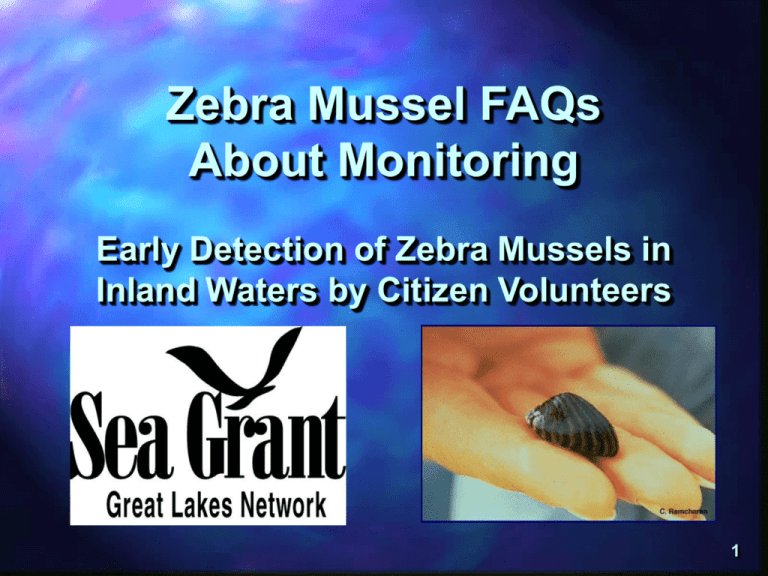
Zebra Mussel FAQs About Monitoring Early Detection of Zebra Mussels in Inland Waters by Citizen Volunteers 1 Zebra Mussels FAQs: What are They? · · · · Small “D”-shaped clams Dark brown and white stripes Native to Caspian and Black seas Arrived in Great Lakes in 1980s in the freshwater ballast of ships 2 Zebra Mussels FAQs: Why Concern? · · · · · · Damage ecology of lakes and rivers Colonize in thick mats on docks, boats, motors, and submerged rocks Kill native mussels Foul beaches with sharp shells and pungent odor Compete with fish for food Clog water supply pipes and boat engines 3 Zebra Mussel FAQs: No known way to get rid of them! 4 Zebra Mussels FAQs: Where Are They? Zebra Mussel Distribution · Spread to many rivers and connected waters in eastern U.S. · Found in inland lakes in only a few states · Not spread far · Thousands of lakes to protect 5 Zebra Mussels FAQs: What Do They Look Like? · · · · · Larvae (veligers) are microscopic Very young feel like fine sandpaper on smooth surfaces, like boat hulls Grow to size of peppercorns Can quickly form barnacle-like colonies Adults over 1/2” long can reproduce Veliger Zebra mussel “peppercorn” 6 Zebra Mussels FAQs: How Can They Spread? · · · · Fouled boat hulls Plants clinging to boat, motor, trailer and other equipment (zebra mussels can attach to plants) Water in bait buckets, livewells, and other areas and equipment that hold water Scuba gear 7 Zebra Mussels FAQs: Who Can Spread Them? · · · · · · Boaters and anglers Sailboat users Personal watercraft users Recreational wild baitfish harvesters Waterfowl hunters Scuba divers 8 Zebra Mussel FAQs: How Can I Prevent Spread? · · · · BEFORE launching….BEFORE leaving: Remove aquatic plants and animals Drain lake or river water Dispose of unwanted live bait on shore Rinse boat and equipment with high pressure, hot water, if moored for more than a day, OR · Dry everything for at least 5 days Protect Your Property and Our Water Resources 9 Zebra Mussels: How Can I Help? · · · · Help build public awareness Know threats posed Learn to recognize Become a volunteer monitor 10 Zebra Mussel Monitoring: Why Should I Help? · Essential to success for prevention and control · Implement containment measures · Develop new control techniques · Mitigate impacts on water users · Because it’s our personal responsibility 11 Zebra Mussel Monitoring Program - Option 1Water Sampling · Sample kits (available on-loan in some states) · Volunteers sample two times during summer, ship water samples to lab for analyses, and ship kit back · Cost is about $100 per season Taking samples 12 Zebra Mussel Monitoring Program - Option 2 Visual Inspection for Juveniles and Adults · Visually inspect two times per season · Examine pontoons, boat lifts, docks, & swimming platforms especially when removing for winter · Can use PVC (4” dia. X 24” long) or brick tied to rope · Always report effort whether you found zebra mussels or not 13 Resources for Zebra Mussel Monitoring Detecting Zebra Mussels video and Detecting Zebra Mussels: A Monitoring Program for Citizens Contact MI Sea Grant, 517/353-5508 Minnesota Zebra Mussel Watch: Volunteer Monitor Instruction Guide Contact MN Sea Grant, 218/726-8712 or MNDNR, 651/297-4888 14 Zebra Mussel Monitoring · Contributes to database · Maintains healthy ecosystems · Brings people together around a common interest · Fosters a sense of community · Provides an early warning program critical for resource protection 15 Veliger Monitoring 16 Written and produced by Mike Klepinger ANS Program Coordinator Michigan Sea Grant Insert Video Video written by Carol Swinehart Michigan Sea Grant 17
